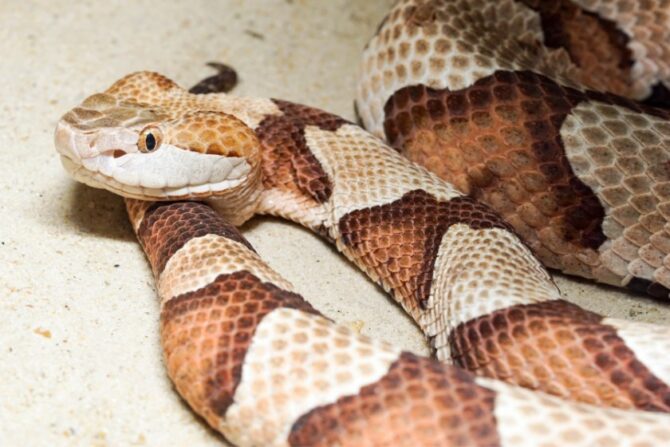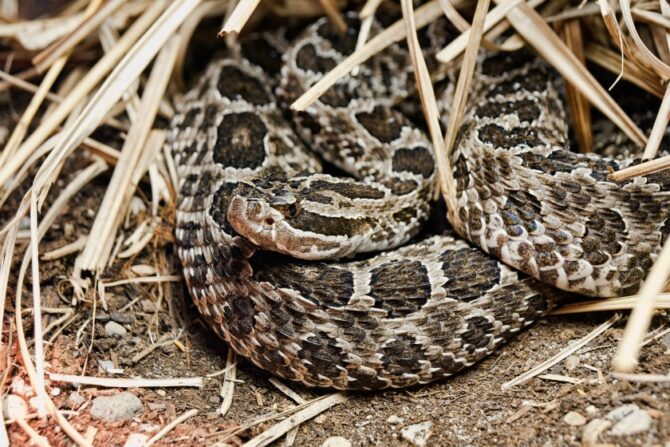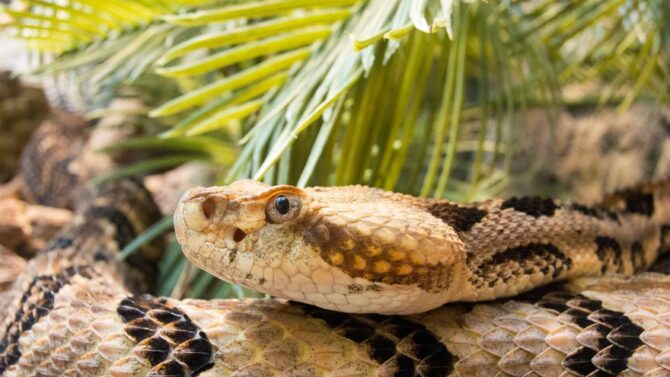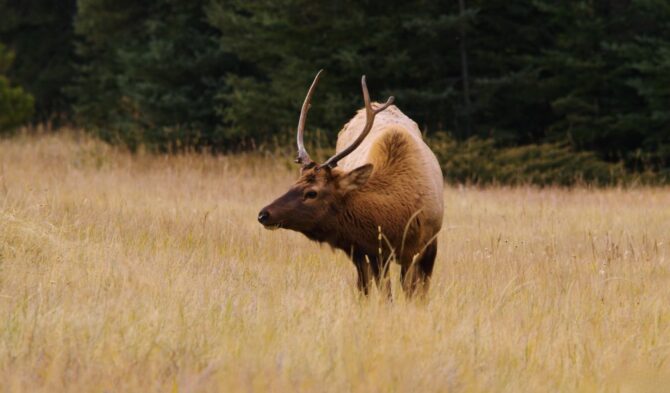There are many species of venomous snakes in the United States of America.
Missouri, a state in the Midwestern region, is no exception.
In this Midwestern state alone, there are five known venomous snake species.
Most of these venomous snakes are found in obscure hillsides along the state’s southern border. Others can be found in the Ozarks and St. Francois Mountains.
All snakes in Missouri are protected by state law, so it is illegal to kill them except when they are a threat to humans.1
The venomous snakes in Missouri are the eastern and Osage copperhead, the northern and western cottonmouth, the timber rattlesnake, the eastern massasauga, and the western pygmy rattlesnake.
Let’s examine each species in detail.
5 Venomous Snakes in Missouri
1. Copperheads

- Scientific Name: Agkistrodon contortrix
- Size: 24 to 36 inches
- Habitat: Rocky, forested hillsides, deciduous trees and shrubs, and swampy regions
- Identifying Features: Coppery eyes with vertical pupils and triangular head
- Behavior: Secretive, shy, loud hissing, and flattened body
- Threats: Rarely fatal venom, warning or dry bite (a bite that doesn’t inject venom), severe pain, tingling sensation, throbbing, swelling, and severe nausea
The copperhead is the most dangerous venomous snake in Missouri.
There are two known types of copperheads: the eastern copperhead (Agkistrodon contortrix) and the Osage copperhead (Agkistrodon contortrix phaeogaster).
Both copperheads belong to a subfamily of venomous snakes called pit vipers.
The eastern copperhead has a dark brown and light reddish brown color.
The Osage copperhead, on the other hand, has a light tan or reddish-tan color, with dark brown to reddish-brown hourglass-shaped bands.
An adult copperhead can grow up to around 24 to 36 inches and has a heavy body.
Its preferred habitat includes trees and shrubs, wooded areas, and swamps.
Most of the time, copperheads only bite humans when they are mistakenly stepped on.
They can be easy to miss, as one of their defense mechanisms is excellent camouflage.
Copperheads stay still even when approached closely and may rapidly vibrate their tails to wade off potential predators and passers-by.
Sometimes, they give warning bites when stepped on.
While these bites don’t inject venom into victims, they can cause excruciating pain, itching, swelling, and nausea.
2. Cottonmouths

- Scientific Name: Agkistrodon piscivorus
- Size: 30 to 42 inches
- Habitat: Streams, lakes, swamps, ponds, and roadside drainage
- Identifying Features: Dark olive-brown color, plain or patterned
- Behavior: Violent flight, rapid crawling, raising head and neck, expanding jaw, vibrating tail, flickering of the tongue, striking forward and crouching
- Threats: Fangs, dangerous bite, huge swelling, amputation, tissue damage, loss of arms
The northern and western cottonmouths are a large species of pit viper.
As aquatic snakes, they are mostly found near slow-flowing waters, shallow lakes, streams, muds, and ponds.
They are predators of most vertebrates and invertebrates, like mammals, birds, fish, eggs, and insects.
Cottonmouths also have blended colors like brown, gray, yellowish-green, or black.
They usually respond to threats from perceived predators by coiling their bodies and displaying their fangs.
They can also vibrate their tails and throw their heads back with their mouths wide open.
Other aggressive displays include hissing, flattening their body, and emitting a strong, pungent secretion from the anal gland at the base of their tail.
Symptoms of their bite include severe pain and swelling, destruction of tissues, bruises, loss of arms, and death (if untreated).
3. Timber Rattlesnakes

- Scientific Name: Crotalus horridus
- Size: 36 to 60 inches
- Habitat: Deciduous hardwood forests, lowlands, wetlands, thick bushes, farms, and residential areas near dens
- Identifying Features: Heavy bodies, stripes, and black tails
- Behavior: Solitary, camouflage, hibernate in dens during winter
- Threats: Hissing, tail vibration, deadly bites, adverse symptoms
The timber rattlesnake (Crotalus horridus) is also known as the canebrake or American viper.
It is the second-largest venomous snake in the United States of America and the largest venomous snake in Missouri.2
It has a prominent rattle at the end of its tail, like every other species of rattlesnake.
Timber rattlesnakes live in rocky cliffs, rivers, flood plains, dens, lowlands, thick bushes, farms, and deciduous forests, among others.
They feed mostly on small mammals such as rabbits, squirrels, rats, and mice and invertebrates such as frogs and snakes.
Timber rattlesnakes inject their prey with venom, wait for it to die, and swallow it whole.
They are not very aggressive and only bite humans as a defense mechanism when cornered.
They strike as the last resort to escape from predators, injecting venom that contains neurotoxins and hemotoxins.
The effects of their venom on victims include external and internal bleeding, cell death, skin darkening, pains and swelling, bruises, numbness, weakness, and sweating.
Timber rattlesnakes are among the animals in Missouri protected by state law.
As they are an endangered species, it is illegal to hunt or kill them.
Any scientific research on them must also be approved by the appropriate regulatory authority.
4. Eastern Massasauga

- Scientific Name: Sistrurus catenatus
- Size: 17 to 40 inches
- Habitat: Wetlands, upland, amongst vegetation, shorelines, and forests
- Identifying Features: Small thick bodies, triangular or heart-shaped heads, vertical pupils. Colors include gray, light brown, and chocolate round patches
- Behavior: Timid, secretive, sluggish
- Threat: Severe bleeding, redness, swelling, hard breathing, death
The eastern massasauga is a rattlesnake species native to Missouri. It is monotypic (that means it has no subspecies).
Eastern massasaugas are small, timid, and secretive. They prefer to hide or withdraw from their predators, especially humans, instead of striking them.
They also hibernate during winter and find a spot to enjoy the heat in summer.
Eastern massasaugas feed on vertebrates like mammals, birds, and lizards and invertebrates like frogs and snakes. Adult eastern massasaugas feed on rodents as well.
The venom of the eastern massasauga is cytotoxic. This means it is highly toxic to cells.
However, the fatality rate is low because eastern massasaugas have short fangs that can inject only a small quantity of venom at a time.
Nevertheless, their bites can cause severe pain and bleeding, redness, swelling, shortness of breath, and death. Those at high risk are children and sick people.
The eastern massasauga is listed as a threatened species by the United States Fish and Wildlife Services under the endangered species act.3 Therefore, it’s unlawful to kill or poach on them.
5. Western Pygmy Rattlesnake

- Scientific Name: Sistrurus miliarius streckeri
- Size: 15 to 20 inches
- Habitat: Flatwoods, sandhills, flood plains, mixed pine-hardwood forests, lakes, and marshes
- Identifying Features: Small, colorful, slender tail with tiny rattle, stripes and spots
- Behavior: Solitary, suns during winter, secretive
- Threats: Bites cause adverse symptoms
The western pygmy rattlesnake is of the subfamily Crotalinae in the Viperidae family. In Missouri, this snake is mostly observed in wood passages and between forests with open bands.
Like other vipers, western pygmy rattlesnakes feed on both vertebrates and invertebrates, like mice, frogs, insects and even other snakes.
The adults also feed on desert centipedes. They sit and wait for their prey and then lure them with their rattling tails.
The reaction of western pygmy rattlesnakes to potential predators varies. They could either coil up, jerk their head and strike, or sound their rattle.
Western pygmy rattlesnakes also have hollow fangs to inject venom into their prey.
Additionally, there are pits between their eyes and nostrils for detecting rodents even in total darkness.
When visiting the forest or woodland in Missouri, secure yourself with adequate protective wear, like boots and thick clothes.
This will help you avoid being bitten by any of these venomous snakes.
However, if you or anyone else gets bitten by one of these venomous snakes, it’s important to report it and get treated immediately to avoid dying.
Final Thoughts
Missouri is home to many dangerous animal species, five of which are venomous snakes.
All the venomous snakes in Missouri play a vital role in the ecosystem, but even non-aggressive ones can cause serious harm to humans.
While we should appreciate their importance and avoid killing them, it’s also important to steer clear of their path.
Their venom can be lethal, and even if getting bitten by them doesn’t result in death, it can still cause serious harm to victims.
So, take necessary precautions when around any snake or in an area where they might inhabit.
References & Notes
- Snakes: Information for Missouri Homeowners. MU Extension
- Venomous Snakes of Missouri. Missouri’s National Heritage
- Eastern Massasauga (Sistrurus catenatus). U.S. Fish & Wildlife Service






